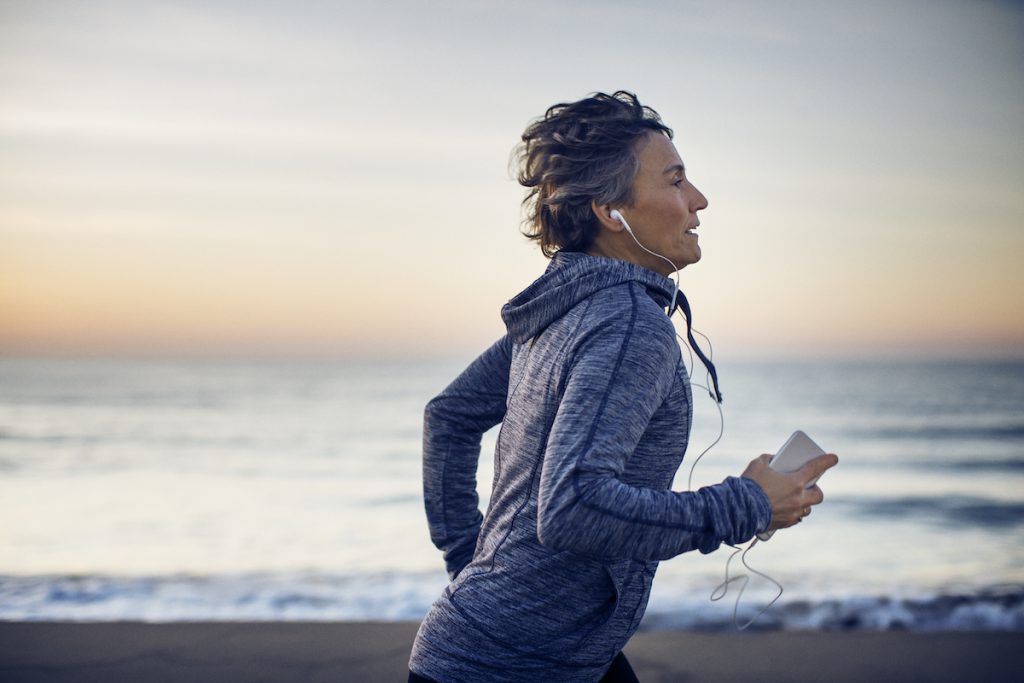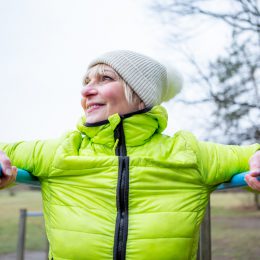3 Ways Climate Change Can Affect Your Fitness Routine
What to consider as the climate changes around you, especially if you’re exercising outside.

The shifts in climate are so big in scope — from widespread drought and flooding to rising ocean temperatures and increasingly intense storms — that the conversation is often focused on what it all means for the planet.
But when you start to zoom in on the effects of climate change, the story that emerges is much more personal. In fact, in a 2021 The Lancet Planet Health survey of nearly 4,000 medical professionals, 77 percent said that climate change would cause a “moderate to great deal” of harm to the health of their patients.
The Centers for Disease Control and Prevention also warns of numerous ways the impact of climate change is impacting individuals’ well-being. Of note, according to the CDC:
- Increased air pollution can get in the way of healthy lung function and boost asthma rates.
- Higher pollen concentrations and longer pollen seasons mean more people may experience year-round and/or more severe allergy symptoms.
- Higher numbers of ticks, mosquitoes, and other disease-carrying insects may bring an increase in Lyme disease, West Nile virus, and more.
- More severe weather events can impact food production and the availability of healthy foods.
- Traumatic events such as floods, heat waves, hurricanes, and wildfires can take a toll on mental health and lead to stress-related conditions.
- More extreme heat events can put more older adults at risk of heat stroke and other heat-related illnesses.
The good news is that there are steps you can take to protect your health from these impacts — and safeguard your fitness routine at the same time. It starts with educating yourself about what’s changing in your corner of the world.
Get and stay fit with SilverSneakers! Choose from dozens of different Community classes, visit a participating fitness location, or view the current schedule of SilverSneakers LIVE online classes here.
Climate Threat to Your Fitness #1: Air Quality
Changing weather patterns mean more locations in the United States and around the world experience hot, humid weather, according to the U.S. Department of Health and Human Services (HHS). It’s the just-right environment for ozone, which is the key component of smog, to stick around.
Ozone aggravates asthma symptoms and makes your lungs work harder, explains Sebastian Lighvani, M.D. He’s an allergist at New York Allergy & Asthma and Lenox Hill Hospital. If you’re in a wildfire- or drought-prone area, you may also be dealing with particles like dust, ash, and smoke that can lead to breathing problems.
Finally, the CDC reports that rising levels of carbon dioxide (CO2) is leading to both higher pollen concentrations and longer pollen seasons. CO2 is a harmful greenhouse gas that not only traps heat in the atmosphere, but causes plants to grow faster.
The result? More pollen and spores are then released in the air. A 2021 study found that pollen season in the United States is now 21 percent longer than it was in 1990. Texas and the Midwest saw the biggest changes.
This is causing more people to have more severe, and more prolonged allergy symptoms, says Dr. Lighvani.
What you can do:
- Make a habit of checking the air quality
- Bring your cardio workouts indoors
Allergy sufferers and those with asthma and other respiratory conditions are already primed to track air quality. Increasingly, it’s something all older adults should start checking regularly, says Dr. Lighvani.
This is true whether you live in a high pollen area like the South and Midwest, or in parts of the country prone to wildfires, he adds.
One way that Lighvani determines his own daily exercise schedule is by using a pollen-tracking app called Allergy Pollen Count. The app’s count is based on air sampling done by specialists certified by the National Allergy Bureau, part of the American Academy of Allergy Asthma & Immunology. You can also check daily air pollution forecasts in your area at AirNow.gov.
“Not everyone has the luxury to change their outdoor exercise schedule based on when pollen counts are lower,” he says. “But if you do, it’s worth the effort because it’s better for your respiratory function and cardiovascular health. Better air quality overall also means less chance of dealing with an allergic reaction.”
You could also strike a compromise with yourself. Instead of an outside run or bike ride, you could go for a less intense walk, for example. The idea is to limit your outdoor activities to things that don’t involve breathing as hard, says Dr. Lighvani. Also, if you have asthma or other lung condition, ask your doctor if they recommend you wear a mask for outdoor activities.
Climate Threat to Your Fitness #2: Heat
Another crucial aspect for fitness is temperature and humidity. Higher temps and humidity tend to affect older people the most, says Scott Kaiser, M.D. He’s a geriatrician and director of geriatric cognitive health for Pacific Neuroscience Institute at Providence Saint John’s Health Center in California.
“In my practice, I spend a lot of time reminding people about how important it is to stay hydrated,” he says. “When you get older, your body has less fluid reserve so it’s easier for you to become dehydrated. That can be very dangerous, and may even become a medical emergency, particularly if you have chronic conditions.”
For example, diabetes increases the risk of dehydration, he says. So do certain medications that might have dry mouth as a side effect. Too little hydration can put undue stress on the heart and kidneys, Kaiser adds, because it creates lower blood volume.
What you can do:
- Carry water with you
- Sip it often
- Eat hydrating foods before and after workouts
- Seek shade on hot days
- Adjust your workout time to the cooler hours of the morning or evening
Whether you’re heading outside for a walk or are doing an indoor SilverSneakers class, make sure to stay properly hydrated, particularly as temperatures increase or humidity becomes heavy, says Dr. Kaiser. He recommends toting your own bottle of water wherever you go — even if you’re just running errands.
Of course, carrying it around isn’t enough. You also need to make sure you’re taking sips at regular intervals. A good rule of thumb is to sip:
Subscribe to our newsletter
It's quick and easy. You could be one of the 13 million people who are eligible.
Already a member? Click to discover our 15,000+ participating locations.
Follow Us
- Before the workout begins
- After the warmup period
- At least once during the active period of a workout
- As needed during the workout
- Before and after the cooldown period
(“It’s always a good idea to drink a little more water than you think you need, even if it’s cool outside,” he adds.)
You can also snack on foods with a high water content before and after exercising. Cucumbers, tomatoes, melons, carrots, lettuce, spinach, and sweet peppers are all good choices. A broth-based vegetable soup after a longer, more intense workout will also help restore the balance of electrolytes that helps keep your body functioning at its best.
On super-hot days, consider moving your workout indoors. There are more than 70 unique SilverSneakers Community fitness classes to choose from. Or get your steps in during a 15-minute Walk Strong (Express) class on SilverSneakers LIVE.
Recommended reading: SilverSneakers Community: 6 Reasons to Get Involved
Climate Threat to Your Fitness #3: Bug-Borne Diseases
Lyme disease, West Nile virus disease, and Rocky Mountain spotted fever are nothing new to the U.S. But longer stretches of high temperatures means the ticks, mosquitoes, and other bugs that transmit these illnesses to humans have more time to stay alive and breed, according to the CDC.
State and local health departments are the best resources to find out how bug-borne diseases are changing in your area.
What you can do:
- Wear insect repellent during any outdoor activity
- Wear long-sleeved shirts and pants when hiking or walking in a wooded area (or doing yard work)
- Do a tick check when you come inside
Look for insect repellents that contain one of the following active ingredients:
- DEET
- Picaridin
- IR3535
- Oil of lemon eucalyptus
- Para-menthane-diol
- 2-undecanone
Take Your Favorite SilverSneakers Classes Online!
SilverSneakers members can access live fitness classes and wellness workshops through SilverSneakers LIVE. See the latest schedule and RSVP for classes here.
Not a member? If you have a Medicare Plan, it may include SilverSneakers—at no additional cost. Check your eligibility instantly here.
Not eligible for SilverSneakers? You can still get 200+ free SilverSneakers On-Demand videos and stay in touch with us by creating your online account.




